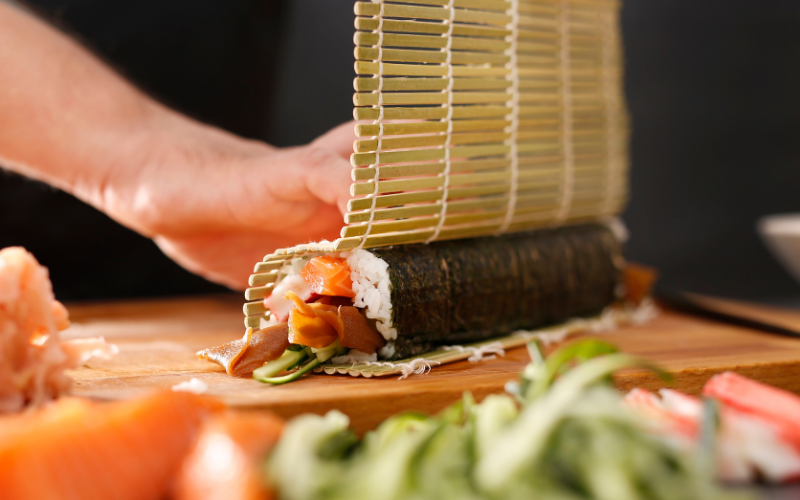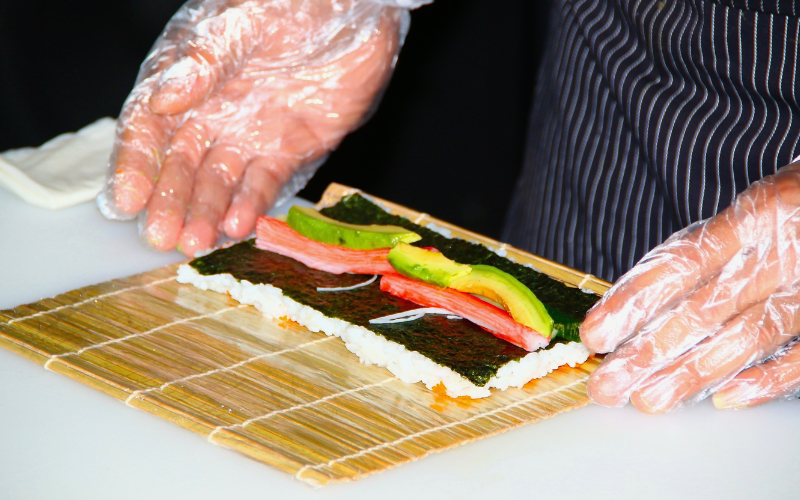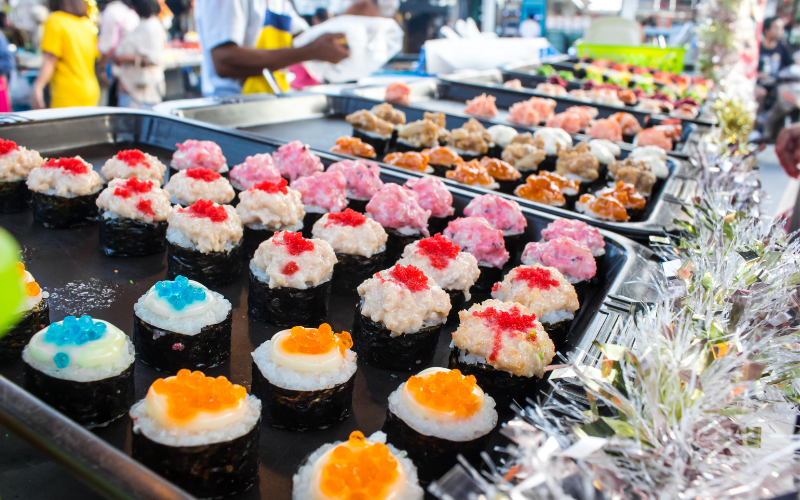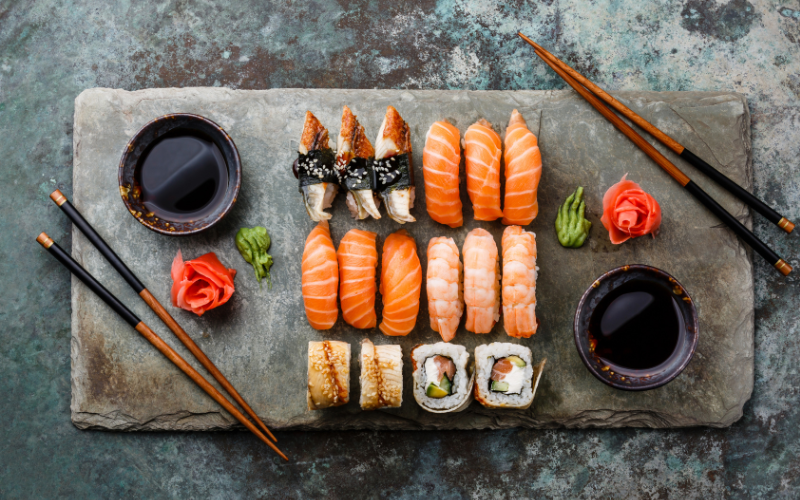Food Safety in Sushi Restaurants: Risks, HACCP and Safe Preparation

Food Safety in Sushi Restaurants: Risks, HACCP and Safe Preparation.
Across continents and cultures, a culinary tide is turning.
Sushi, once a treasured tradition of Japan, has swept the globe, captivating taste buds with its unique blend of flavours and textures.
The numbers speak for themselves: with over 3 billion people savoring this raw fish delicacy, it’s no surprise that sushi restaurants claim a significant chunk of the international cuisine market.
Even as diverse Asian flavours climb the popularity ladder, sushi reigns supreme, holding a place of honour among culinary favorites worldwide.
But with every trend comes responsibility, especially when raw fish comes into play.
While the artistry of presentation and the explosion of modern sushi variations entice us, understanding the food safety concerns lurking beneath the surface becomes crucial. Navigating this global phenomenon requires informed choices and a keen awareness of potential risks.
This article dives deeper than just the deliciousness and vibrant aesthetics of sushi.
We embark on a comprehensive exploration of food safety in sushi restaurants: from exploring the nutritional benefits and diverse varieties to identifying potential hazards and selecting trustworthy establishments, your customers will always enjoy risk-free sushi at your premises.
Preparing sushi: a step-by-step guide
Sushi is a dish composed primarily of rice seasoned with rice vinegar, combined with other ingredients such as raw fish, seafood, seaweed, vegetables, and eggs.
The preparation of sushi can vary depending on the region and the type of sushi being made, but the following steps are generally common to its preparation process:
- Cook the rice in a pot or rice cooker. Then, add rice vinegar, sugar, and salt. Mix well and let it cool.
- Prepare the ingredients that will be used in the sushi, such as raw fish, seafood, vegetables, etc. Cut them into thin strips or small cubes.
- Cut the nori seaweed into sheets of the desired size for the sushi.
- Spread a layer of rice on the nori sheet. The rice is spread evenly over the sheet, leaving a one-centimetre border at the top to seal the sushi.
- Place the ingredients on top of the rice: either in the centre of the rice or in a diagonal line.
- Roll the sushi with the help of a bamboo mat called makisu. Press firmly so that the sushi is compact and cut into thin slices.
- Serve the sushi cold with soy sauce, wasabi, and pickled ginger.
Preparing sushi requires skill and practice. It is not easy to achieve the perfect texture and flavour, especially when it comes to raw fish!
Is Sushi as healthy as we think?
It is important to note that the sushi rolls offered in many fast food establishments contain very few nutrients from the fish, fruits, vegetables, and seaweed used in traditional sushi preparation, which we discussed in the previous section.
Their main ingredient is usually pearled white rice, which has lost most of its fibre, vitamins, and minerals.
In addition, these rolls are added sugar, which could lead to a high intake of easily absorbable sugars.
Many types of sushi are prepared with high-fat sauces, such as spicy mayonnaise. Others are coated in tempura batter and fried, so their energy value is considerable.
However, many sushi restaurants only use fresh, top-quality products.
And we know this because we work with them!
Miss Sushi, for instance, is a popular sushi chain in Spain is known for its cuisine made with exquisite, top-quality, fresh and made-to-order products, presented to the consumer at very affordable prices.

Each of the Miss Sushi franchises encompasses four concepts in one: physical restaurant, home delivery, take away, and catering, all of them featuring a wide variety of top-quality, fresh and made-to-order products.
In other words, much of the nutritional value of sushi depends on the preparation processes and the quality of the ingredients selected by the restaurant that prepares it.
In the case of Miss Sushi, you can be sure that the quality and processes are impeccable.
Food safety in Sushi restaurants: Risks in Preparing Sushi
Some publications talk about the “dark side” of sushi or describe raw fish, one of its main ingredients, as a “pathogen paradise.”
They claim that it is a “potentially dangerous food product, as it uses raw fish and shellfish, which are susceptible to harboring parasites, bacteria, and heavy metals.”
It is true that the preparation of sushi can carry certain health risks… if the proper precautions are not taken, as with so many other types of cooking.
Some of the most common risks are:
Bacterial Contamination
Raw fish used in sushi preparation can be contaminated with harmful bacteria such as Salmonella, E. coli, and Listeria.
If not handled properly, the bacteria can spread to the rice and other ingredients.
However, anisakiasis is the disease most frequently associated with sushi consumption.
The larvae can invade the fish tissues and, if consumed raw or not cooked properly, can infect the consumer, causing digestive system disorders and triggering allergic reactions, even in severe cases.
Fish Poisoning
The fish used in sushi preparation must be fresh and of high quality to avoid food poisoning. If fish that has been stored for too long is used, it may contain high levels of histamine, which can cause symptoms such as nausea, sweating, and redness.
Food Allergies
Many people are allergic to the raw fish used in sushi, as well as other ingredients such as shellfish and eggs. If not properly prepared, sushi can be a source of food allergies.
Cross-contamination
If the same kitchen utensils are used to prepare different types of sushi, cross-contamination can occur. For example, if the same cutting board is used for raw fish and vegetables, the vegetables may be exposed to the bacteria present in the fish.
To minimise the risks in sushi preparation, it is important to:
- Use high-quality ingredients.
- Handle raw fish carefully.
- Maintain good kitchen hygiene.
- Avoid cross-contamination.
- Follow proper food safety guidelines, which we will discuss in more detail below.

Is Sushi safe for Pregnant Women to consume?
In general, experts recommend that pregnant women avoid eating sushi, especially those that contain raw or undercooked fish.
This is because some fish, especially large ones, can contain high levels of heavy metals such as mercury, cadmium, and lead, which can be harmful to fetal development.
As mentioned above, sushi can also be contaminated with bacteria or parasites, such as anisakis, which can cause illness and complications during pregnancy.
The European Food Safety Authority recommends that pregnant or breastfeeding women and children under ten years of age avoid eating sushi.
In any case, it is best to consult with a doctor or nutritionist to obtain specific recommendations about diet during pregnancy.
Why is it Necessary to Maintain High Standards of Hygiene and Food Safety in Sushi Restaurants?
The preparation of sushi requires high standards of hygiene due to the following factors involved in its preparation:
- Raw ingredients: As mentioned above, sushi is made with raw ingredients, such as fish and shellfish, which can contain pathogenic microorganisms and parasites. Therefore, it is important to maintain high standards of hygiene to prevent contamination of ingredients and reduce the risk of foodborne illness.
- Quick consumption: Sushi is consumed quickly in small portions, which means that any contamination can affect a large number of people in a short time. Therefore, it is important to ensure proper hygiene during preparation to minimize the risk of foodborne illness.
- Storage: The preparation of sushi requires proper storage of ingredients, especially raw fish and shellfish, to prevent the growth of bacteria and other microorganisms. A proper cold chain must be maintained and the expiration date of the ingredients must be controlled.
- Handling: The handling of sushi ingredients is also critical in preventing contamination. It is important that cooks and kitchen staff follow proper hygiene standards, such as washing their hands frequently, using clean utensils, and disinfecting work surfaces.
How to ensure the safe preparation of Sushi
Nerea Cristófalo, food technologist at Andy, recommends following these steps to ensure the safe preparation of sushi in your kitchens:
1. Fresh and quality ingredients from guaranteed suppliers
Make sure to purchase fresh and quality ingredients for sushi preparation in your restaurant(s) from trusted suppliers to avoid contamination and ensure food safety.
You must check the expiration date of the ingredients and keep a supplier control record.
2. Correct storage of ingredients
Store ingredients properly, controlling the storage temperature and the receiving temperature.
3. Freezing and storage of fish and shellfish
You must ensure that fishery products derived from fish (except freshwater fish) or mollusks that will be subjected to insufficient treatments to kill anisakis larvae have been frozen at a temperature equal to or lower than:
a) -20 °C for a minimum of twenty-four hours.
b) -35 °C for a minimum of fifteen hours.
The freezing process can be carried out by the establishment or the supplier, as long as it is justified in a document.
⚠ But beware!
If fishery products are subjected to a heat treatment that kills the parasite before consumption (i.e., that reaches a minimum temperature of 60°C in the centre of the product for at least one minute), it is NOT necessary to freeze the fish or mollusk beforehand.
Your restaurant(s) or establishment(s) must inform consumers using posters or menu cards that the products have been frozen or that they come from aquaculture systems that guarantee that they are free of anisakis.
Afterward, raw fish and shellfish must be stored at a suitable temperature in an uninterrupted cold chain, and a record of temperature control, reception and defrosting of the fish must always be kept.
4. Adequate cooking and cooling of rice
It is essential to cook the rice properly and cool it quickly, as if it is not cooled quickly enough, it can result in the proliferation of bacteria and become a source of food poisoning.
To prevent this, it is recommended to refrigerate the rice immediately after cooking or acidify it with a rice vinegar solution until it reaches a pH below 4.6.
It is important to mix the rice with a vinegar solution and regularly check its pH level.
After cooking the rice, it should be divided into small portions so that it cools quickly to room temperature.
It is recommended to keep a record of the pH of the rice to ensure that it is properly treated and to avoid food safety problems.
It is also important to use clean utensils and handle products on disinfected and separate surfaces to avoid cross-contamination.
It is recommended to use clean and disinfected bamboo mats, or to change the plastic film every 2 hours.
Logically, it is essential that handlers wash their hands frequently during sushi preparation and that work surfaces and utensils are disinfected before preparation.

5. Serve immediately
Sushi should be served immediately after preparation to prevent the growth of bacteria.
In summary:
-
-
-
Safe sushi preparation requires following proper food hygiene, storage and handling practices to ensure food safety and prevent foodborne illness.
-
Records should be kept and training and evaluations should be carried out to ensure safe preparation and excellent service of sushi.
-
It is important to carry out a training plan, have training articles and videos in the library and carry out evaluations of the team with Andy.
-
-
How to display Sushi on a counter
Proper Temperature: Keeping sushi refrigerated is essential to ensure food safety in sushi restaurants and prevent bacterial growth. The ideal storage temperature is between 0 and 5 degrees Celsius. It is important to check the temperature regularly and make sure that the refrigeration equipment is working properly.
Cleanliness of the Display: The sushi display should be kept clean and free of debris to prevent bacterial accumulation. It is important to clean the display surfaces regularly and avoid using porous materials that can harbor bacteria.
Product Rotation: To ensure the freshness of the sushi, it is important to rotate the product regularly and remove any that has passed its expiration date. It is also important to make sure that the sushi has not been exposed to high temperatures during transport or storage.
Clear Labelling: It is essential to label the sushi correctly to inform the consumer about its contents and expiration date. Labelling also helps to ensure that the sushi is kept in proper conditions during its display.

HACCP protocols to be followed to ensure food safety in sushi restaurants
In addition to the basic steps recommended by our food technology consultant Nerea in the previous section, you should have clear and effective HACCP (Hazard Analysis and Critical Control Points) protocols to identify, evaluate, and control food-related hazards.
Here are the HACCP protocols that teams should follow to guarantee food safety in sushi restaurants:
Hazard Identification: Biological, chemical, and physical hazards associated with sushi should be identified, such as the presence of bacteria, parasites, or heavy metals in fish, which we have already mentioned above.
Establishment of Critical Control Points (CCPs): Critical control points should be established in the sushi production process, such as fish reception, storage, handling, preparation, cooking, cooling, and packaging.
Establishment of Critical Limits: Critical limits should be established for each critical control point, such as the storage temperature of the fish or the maximum exposure time to the environment before consumption.
Monitoring of CCPs: Monitoring procedures should be established for each critical control point, such as measuring the temperature of the fish storage refrigerator.
Corrective Actions: Corrective actions should be established for each critical control point that exceeds the established critical limits, such as discarding the fish or reevaluating the handling and storage procedures.
System Verification: The HACCP system should be regularly verified to ensure that it is functioning properly and to take corrective action when necessary.
Documentation: All procedures, monitoring, and corrective actions should be documented so that they can be reviewed later in case of any irregularities or problems.
How to implement a HACCP Plan in a Sushi Restaurant?
A HACCP (Hazard Analysis and Critical Control Points) plan for a sushi restaurant consists of the following steps:
Formation of the HACCP Team: A HACCP team should be formed consisting of people who are familiar with the sushi production process and who understand the principles of HACCP.
- Description of the Sushi Production Process: The sushi production process should be described in detail, from fish reception to delivery to the customer, including all intermediate stages.
- Hazard Identification: The HACCP team should identify all hazards that may occur during the sushi production process. Hazards are divided into three categories: biological, chemical, and physical.
- Determination of Critical Control Points (CCPs): Critical control points (CCPs) should be identified in the sushi production process where the identified hazards can be controlled. These points must be controlled to prevent the hazards from reaching a level that is dangerous to the health of the consumer.
- Establishment of Critical Limits: Critical limits should be established for each CCP. Critical limits are the maximum or minimum limits that should not be exceeded. For example, the storage temperature of fish should be below 5°C.
- Development of Control Procedures: Control procedures should be developed for each CCP. These procedures indicate how each CCP will be controlled and how the critical limits will be measured.
- Establishment of Corrective Actions: Corrective actions should be established to be taken in case the critical limits are exceeded. This includes identifying the problem, eliminating the cause of the problem, and documenting the action taken.
- System Verification: The HACCP system should be regularly verified to ensure that it is functioning properly and to take corrective action when necessary.
- Documentation: All procedures, monitoring, and corrective actions should be documented so that they can be reviewed later in case of any irregularities or problems.
It is important to note that a HACCP plan should be reviewed regularly to ensure that it remains effective and adapts to changes in the sushi production process or health regulations.
t is undeniable: food safety in a sushi restaurant is a set of important processes, but very repetitive, and quite tedious for your employees.
But, don’t worry.
Andy has been designed and developed precisely to help your kitchen teams at every step of the food safety protocols of a sushi restaurant.
Why is food safety training key in sushi restaurants
Food safety training for teams is key in sushi restaurants for the following reasons:
- Protection of Consumer Health: Sushi restaurant teams must know the basic principles of hygiene and food safety to prevent food contamination, which can cause illness to consumers.
- Compliance with Health Regulations: Sushi restaurants must comply with the food safety rules and regulations established by the health authorities, and this implies that teams must know and apply these rules and regulations.
- Prevention of Occupational Risks: Sushi restaurant teams must know and apply the necessary safety measures to avoid workplace accidents, such as cuts or burns.
- Improvement of Service Quality: Sushi restaurant teams that have food safety training can offer a higher quality service to the customer, by ensuring that food is produced and handled safely and appropriately.
Eliminate risks and optimise food safety in sushi restaurants with Andy
Andy is the leading food safety digital assistant for the food service industry, assisting major international brands like Domino’s Pizza, NewRest, Starbucks and well-known sushi chains like Miss Sushi!

Andy guides their teams in their food safety tasks in a friendly and intelligent way, preventing, worrying, and ensuring that quality work is done in the shortest possible time.
Andy digitises all actions relevant to food safety processes, traceability, labelling and hygiene of the workspace, considerably reducing the time that the team dedicates to them, and facilitating compliance with all HACCP, Hygiene, labelling records, etc.
The following are some of the tasks with which Andy helps to keep sushi restaurants risk-free for consumers:
1. Digital HACCP
Andy digitises cleaning and hygiene records, maintenance, temperatures and any necessary checklist, ensuring that they are always in compliance with the law.
By automating all HACCP tasks with Andy, it is possible to comply with all mandatory records while activating corrective plans automatically, streamlining operations, from taking temperatures to implementing corrective actions, establishing acceptable limits and frequency of monitoring.
Andy guides teams and ensures that procedures are performed correctly and always on time.
👉Find out more about digital HACCP with Andy👈
2. Food safety labelling
Our efficient food safety software for sushi restaurants also has the ability to label products and ingredients much faster and easier, ensuring greater food safety in all types of kitchens.
👉Find out more about food safety labelling with Andy 👈
3. Incident Management
Andy automates any incident that occurs in a commercial kitchen with simple and effective corrective plans.
Andy has the power to help resolve non-conformities and activate the correct action plan to address in a fraction of the time that kitchen teams typically spend, ideal for ensuring food safety in all types of restaurants, including those that specialise in buffets free, hotels, schools, etc.
Through an effective notification system, any incident is no longer an incident in record time!
👉Find out more about managing incidents with Andy👈
4. Internal Communication
Andy facilitates efficient internal communication through its internal chat.
A secure environment from which to transmit information in document, video, or even image format that are found in the Andy resource library.
5. Internal Audits
With the audit plan integrated into Andy, you can control participant access, customise scores and collect all inspections in one place.
In addition, Andy can help you with the following specific food safety processes in sushi restaurants, as it does in the kitchens of our Partner Miss Sushi:
- Temperature control records, opening and closing checklist of the premises.
- Preventive maintenance plans.
- Exhaustive control of the reception of salmon and tuna.
- Control of the labelling of all its products in all its stages, both freezing, thawing, refrigerating, reception, drying, opening and production.
- Control of their fresh vegetables, from reception, storage and shelf life when they are in production.
- Control of the production of sushi, labelling the expiration date for production of: seaweed, shiitake, salmon, tuna, avocado, mango, and the time of production of the roll.
- Control of the preparation of rice, made day by day: from the reception to the moment they use it to make sushi.
- General communications to all stores from the Andy diet, informing, for example, that they have new files in the library.
- They take great advantage of the use of the library to provide training to the team: videos of preparations on how to make each type of sushi, recipes, HACCP plan, promotions by menus, and communication of changes in procedures/preparations/recipes.
So, if you are launching into a new business venture in the food service industry, make sure you integrate Andy in your kitchens to guarantee the safety of all your customers who trust your sushi restaurant/s!
👉🏽 Try Andy’s many advantages absolutely FREE for 10 days! 👈🏽




